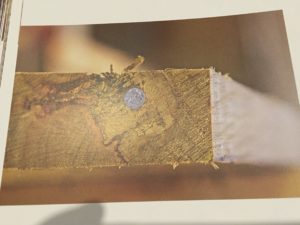 As soon as I got home from touring the Draken Harald Harfagre, I wanted to find a book to tell me all about it, and I found this beautiful volume available from The Wooden Boat Store. The book is about the building of the ship, from examining the archaeological evidence, to finding the trees to build the ship, to the sail, the ropes, the carvings, and the modern conveniences like radar and a motor that make it a little less of a risk to sail.
As soon as I got home from touring the Draken Harald Harfagre, I wanted to find a book to tell me all about it, and I found this beautiful volume available from The Wooden Boat Store. The book is about the building of the ship, from examining the archaeological evidence, to finding the trees to build the ship, to the sail, the ropes, the carvings, and the modern conveniences like radar and a motor that make it a little less of a risk to sail.
The book is in both Norwegian and English, and full of beautiful full-page pictures of the process of building the ship. It is put together in the “clinker-built” style of 19th century boats. It’s called “clinker” because hundreds of nails are used, and then the ends of the nails are hammered by hand which makes a clink noise until they are pounded round by the hammer’s blow. It takes approximately 100 blows on each nail.
The Draken Harald Harfagre is the first modern viking ship built by ship-builders instead of archaeologists. Viking ships that have been unearthed often have curved keels, but it’s possible that the keels warped after being under ground for over a thousand years. After doing tests with small mock-ups, the builders discovered that a straight keel performed better.
The sail is made of silk, which is lighter than the wool that most viking ships would have used. In the Viking Age, silk would have had to be imported at enormous cost, but it was not unknown for a king’s ship to have a silk sail. The Draken Harald Harfagre uses hemp rope, which is not historically accurate, but the two materials used for rope in the Viking Age, lime bast (bark from a lime tree) and seal skin, were not practical or humane.

Perhaps my favorite anecdote was from tree selection. They cut down a tree from a Danish forest, cured it and began sawing it, and found a musket-ball in it from the Napoleonic war! It’s such an amazing palimpsest of history, and also gives an idea of how old the trees that went into ships were.
The ship has many “knees”, which are single pieces of wood with a right angle bend in them, that secure the sides of the ship to the bottom. I should have realized this by looking at them, but was very interested to learn that all of those knees are carved from a section of root where it meets the trunk, and they have to find just the right angle. The knees are extremely strong and heavy.
Sourcing the timber was a challenge–many of the best trees were found in Germany, not Norway, since Germany has done a better job with its forestry over the centuries. The builders worked with German forest rangers to select trees that were not so old they were protected by law, and also whose removal would not threaten the forest’s ecology.
The book is a bit of an investment, but totally worth it to me! Not only are the construction techniques interesting, but the personalities of the team that built it emerges, and they are all charming.